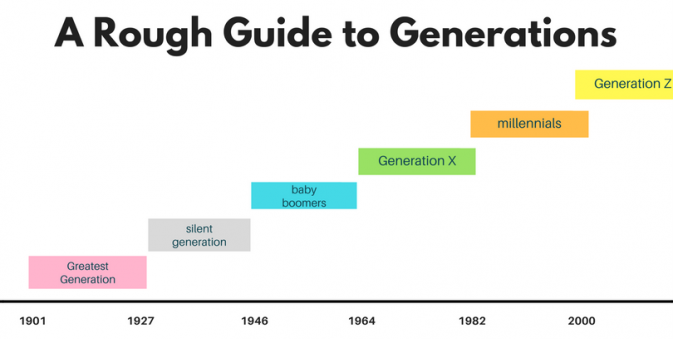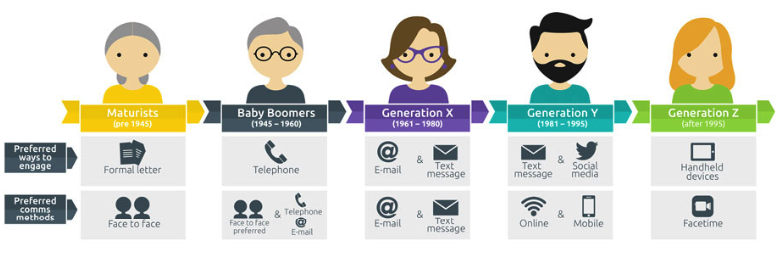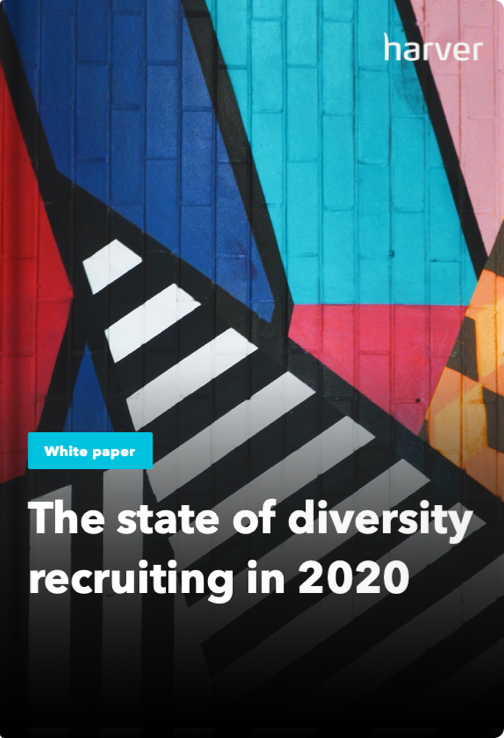The generational diversity in the workplace is growing. From seasoned Baby Boomers with years of experience to fresh-faced Generation Z-ers who are constantly connected, the workforce is becoming increasingly varied in terms of age.
Today, companies often employ people from up to four different generations—and it’s no surprise that each generation has their own unique style, needs, goals, and traits for employers to consider.
While managing such an age-diverse workforce is certainly not without its challenges, there are many benefits to employing a team that spans multiple generations.
By 2025, 99,3% of the US workforce will comprise Baby Boomers, Generation X, Millennials and Generation Z. (Image source)
However, to take full advantage of said benefits, it’s important that you understand the common issues employers face, as well as the best ways to address them.
Isn’t that something you’d like for your company?
In this article, we’ll look at generational diversity in the workplace, review some of the benefits and issues associated with it, and share some of the best practices that will help you approach the growing age gap at work.
Listen to how you can manage generational diversity in the workplace on the Recruitment On The Go podcast!
Overview of tips on how to manage generational diversity in the workplace
- Adapt your recruiting strategies.
- Avoid making age-based assumptions & stereotyping.
- Listen to your employees and find out what they want.
- Customize your approach for each employee.
- Adopt varying communication styles.
- Refine your techniques for delivering feedback.
- Assemble age-diverse teams for projects.
- Establish employee retention practices.
First, let’s take a minute to learn a little bit more about the four generations and their characteristics in the workforce.
Like what you see?
Don’t miss out. Subscribe to our quarterly digest to get the latest TA and TM resources delivered right to your inbox.
Breaking down the generations
1. Baby Boomers were born between 1946 and 1964. This generation is known for having a strong work ethic, placing significant importance on professional accomplishments, and for being somewhat reserved from a social perspective.
Because they’re so hardworking, the Baby Boomers are often considered the “workaholic” generation. Not surprisingly, they’re also very goal-oriented and competitive. Because they grew up making phone calls and writing letters, Boomers often prefer one-on-one communication and phone calls over email and instant messaging.
2. Generation X was born between 1965 and 1980. Because they’re the least studied of the current generations at work, Gen X is sometimes referred to as the “middle child” between the ever-popular Boomers and Millennials.
Joining the workforce after the hardworking Baby Boomer generation, Generation X is widely credited for creating the concept of work/life balance. They’re known for being extremely independent and self-sufficient, valuing freedom, and shunning micro-management in the workplace.
While they may not be as tech-savvy as the younger generations, Gen X-ers are actually quite technologically adept. A study revealed that 54% of Generation X leaders are digitally savvy—which is on pace with 56% of Millennial leaders.
3. Generation Y, also referred to as Millennials, was born between 1981 and 1996. This generation, which is already the largest in the workforce, will make up three-quarters of the global workforce by 2025. Millennials thrive on new innovations and the scrappy “startup” mentality.
Similar to the Generation X managers that paved the way, Millennials desire work/life balance and crave flexibility in the workplace, such as working from home and casual dress. They aim to work smarter, rather than harder—making them excellent at multitasking.
Despite the eagerness that Millennials bring to the table, this generation is often criticized for being self-involved and overly dependent on technology. They also require a significant amount of feedback from employers.
4. Generation Z was born between 1997 and 2015, making them the youngest generation in the current workforce. They are the first generation to grow up in a world that is completely wireless. As true digital natives – even more so than Millennials – Generation Z is constantly connected and is considered the most tech-savvy of these groups.
This generation is known for being creative, flexible, and self-reliant. While Gen Z-ers share many similarities to Millennials, they’re more cautious and concerned with career stability. Because they’re connected at all times, Gen Z-ers are excellent multitaskers, but also easily distracted. With shorter attention spans at work, they require bite-sized, immediate feedback from their employers.
Generation Z will be followed by what is known today as Generation Alpha. (Image source)
It’s clear that each generation has very distinct characteristics and working styles. With four dramatically different generations working together as one, it goes without saying that some problems will arise. Let’s break it down.
What problems stem from generational diversity in the workplace?
Because each generation has such unique characteristics, things will likely not always be smooth sailing when the age gap rears its ugly head. As an employer, it can be very challenging to manage the expectations of multigenerational employees—each one has completely different expectations and priorities.
However, understanding the potential challenges is the first step to solving them. Let’s elaborate on the problems that can stem from generational diversity in the workplace.
Risk of conflicts
With each generation having such distinctive traits and characteristics, there is a potential risk of conflicts occurring due to clashing values and beliefs, work ethics, and communication styles.
Interpersonal issues are often one of the biggest problems that employers face when dealing with generational diversity. When employees who are decades apart in age work closely together, they can sometimes have trouble getting along—not to mention that conflict reduces employee engagement and decreases productivity.
Lack of mutual understanding
With multiple generations between them, it’s not surprising that a Boomer and a Gen Z employee might clash—they simply can’t relate.
This can cause a lack of mutual understanding, making it challenging for team members from different generations to communicate and collaborate effectively. Because the generations are each so distinct, stereotyping can be a significant issue that causes a divide among employees.
Different working styles
Each generation has a distinct working style, and they’re likely to clash now and again. While Baby Boomers are comfortable working long hours and prefer working on-site, Gen Y and Gen Z employees prefer more flexible hours and the option to work remotely.
As we highlighted above, employees across generations also have different preferences when it comes to how they receive feedback and collaborate with others in the workplace—meaning it’s not always easy to work together seamlessly.
Communication gaps
These generations not only have different working styles, but also differing communication styles. This is in large part due to technology, as each generation uses it to communicate in very different ways. While Baby Boomers are willing to use technology for productivity purposes, they prefer to communicate face-to-face or over the phone.
On the flip side, the younger generations embrace digital communication through email and instant messaging. These different styles can lead to miscommunication or lack of communicating at all—both of which pose an obvious problem.
While Baby Boomers might prefer telephone calls, it is not a preferred way of communication of later generations. (Image source)
Despite the obvious challenges that come with generational diversity in the workplace, it can still be an indispensable contribution to your company’s success for a variety of reasons. Here’s why.
There are many ways that companies can benefit from embracing generational diversity in the workplace. Employees from different generations can offer unique perspectives and bring different strengths to the table. Generational diversity can benefit your organization and you’re about to find out how.
- Problem-solving: Because each generation has a different approach solving problems, having a multigenerational workforce can be very beneficial when it comes to identifying potential solutions and new ways of addressing day-to-day issues.
- Understanding different audiences: Each generation is very unique—which is a great asset to your organization. By employing people from each of these generations, you can better understand the different target audiences that you’re trying to reach.
- Learning opportunities: Generational diversity at work presents learning opportunities for all employees—and not just the younger ones. Across generations, employees can teach each other new ways of approaching things and more efficient ways of doing business. For example, a more technologically adept employee might know a faster way for a Boomer to approach a manual, tedious task at work.
- Mentoring: A multigenerational workforce is the perfect environment for mentoring. Many organizations opt to start a mentoring program to allow employees the opportunity to educate one another. This not only helps employees gain new skills and information but also improves how they work alongside each other.
If you’re wondering what you can you do to take full advantage of having a multigenerational workforce, we’ve got you covered.
What are best practices for approaching generational diversity?
By following a few best practices, you can reap the full benefits of generational diversity in the workplace and get ahead of any potential problems before they crop up. Here’s what you can do.
1. Adapt your recruiting strategies.
If you want to benefit from generational diversity, you need to be able to recruit people across generations as well. In your job ads, be careful about using age-discriminating formulations.
Instead, craft your message to appeal to diverse candidates. Baby Boomers might positively react to mentions of your company’s industry awards or other successes while Millennials would care more about personal development opportunities and social responsibility.
Make sure to distribute your vacancies via various channels, depending on where you can reach your potential candidates easily. Think about reaching Baby Boomers via your professional network or referrals and ever-connected Generation Z via interactive online campaigns.
Do not underestimate the power of social media recruiting. The use of social media is common across all generations. Over 60% of people aged 50-64 use at least one social media site.
Encourage the candidates to ask a lot of questions during interviews to find out what they are looking for and what they expect. Then, you will be able to make an informed decision whether a candidate and your company are a match.
The state of diversity recruiting in 2020
2. Avoid making age-based assumptions & stereotyping.
Stereotypes are the worst—and whether they’re true or false, they’re not doing anyone any favors. In order to take full advantage of your multigenerational workforce, avoid making any assumptions or stereotyping based on age.Instead, talk to each of your employees and learn about their individual preferences and working styles.
One of the common prejudices is that older people are not very comfortable with technology. However, a recent survey has found out that people over 55 are less likely to find using tech in the workplace stressful than their younger colleagues.
Internet usage penetration in the US
The internet usage penetration has been growing among all age groups in the US over the past decade. (Image source)
3. Listen to your employees and find out what they want.
Instead of making age-based assumptions about the needs of employees, take the time to listen to each employee and find out what they want. This will open the lines of communication, help you work together more efficiently, and improve employee engagement.
4. Customize your approach for each employee.
Each employee is a unique individual with different preferences, goals, skills, weaknesses, and ways of communicating. Rather than generalizing and treating everyone the same, you should take a custom approach with each employee.
Customizing your approach and tailoring your style to each individual will allow for improved working relationships and happier employees overall.
5. Adopt varying communication styles.
While Boomers opt for phone calls, Millennials prefer to communicate digitally through instant messaging and texting. The two younger generations are also more likely to enjoy working in a collaborative manner.
Because each generation has different communication styles, you should adopt various styles of communicating with them. Learn what each employee’s preference is and then adapt to that style.
Furthermore, different generations can learn from each other. For example, MasterCard has been offering a one-on-one‘Social Media Reverse Mentoring’ program where younger employees help the older ones familiarize themselves with various social media platforms.
6. Refine your techniques for delivering feedback.
Gen X employees want to be left alone, while Gen Z employees want immediate, bite-sized feedback on their performance. Next to adopting varying communication styles, you should refine your techniques for delivering feedback and apply them based on employee preferences.
Taking a personalized approach will not only make employees happy but also make it easier to deliver effective, meaningful feedback.
7. Assemble age-diverse teams for projects.
By creating age-diverse project teams, you can leverage the unique strengths of each generation, while also encouraging team members to collaborate and build relationships with one another. Despite possible conflicting opinions or disagreements, 89% of employees in Australia prefer to work with age diverse colleagues.
For example, a Gen Z employee might be aware of the latest technology and social media platforms, while an experienced Boomer might have invaluable knowledge of the industry you work in.
Age diversity in teams is one of the keys to better decision-making at work. (Image source)
8. Establish employee retention practices.
Employee turnover is costly, bad for morale, and often puts a strain on the company’s day-to-day operations until a replacement is hired. By developing an effective employee retention program, you can address some of the pain points that cause employees to jump ship.
Some of the most effective strategies for retaining talent despite cross-generational conflict include fostering teamwork, improving communication, and building a mentorship program.
On a final note
While generational diversity in the workplace can be challenging for both employers and employees to navigate, it can also be a strong competitive advantage for companies that embrace it. Companies like HIII, PNC, or AT&T have cross-generational mentorship programs, benefiting both the mentors and the mentees. Such programs can help increase diversity and inclusion at the workplace.
By fostering a culture that celebrates collaboration, keeping the lines of communication open, and tailoring your approach to each individual, you can get ahead of any potential conflicts before they arise and reap all of the benefits of a multigenerational workforce. How amazing is that?
The state of diversity recruiting in 2020








